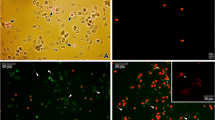Abstract.
Two commercially valuable mollusc species (Ostrea edulis and Tapes decussatus) were experimentally contaminated with Cryptosporidium parvum oocysts. A direct immunofluorescent antibody technique and inclusion/exclusion of the fluorogenic vital dye propidium iodide were used to test for the presence and viability of the oocysts, showing that transmission of contamination occurred between coexisting species. There was a decrease in the viability of oocysts in the initially uncontaminated molluscs as well as a large decrease in the number of oocysts retained when dead molluscs were used as the source of contamination. The results show the potentially important role that these molluscs play in spreading contamination in depuration plants and areas where aquatic organisms are cultivated.
Similar content being viewed by others
Author information
Authors and Affiliations
Additional information
Electronic Publication
Rights and permissions
About this article
Cite this article
Gómez-Couso, .H., Freire-Santos, .F., Ortega-Iñarrea, .M. et al. Environmental dispersal of Cryptosporidium parvum oocysts and cross transmission in cultured bivalve molluscs. Parasitol Res 90, 140–142 (2003). https://doi.org/10.1007/s00436-002-0748-7
Received:
Accepted:
Issue Date:
DOI: https://doi.org/10.1007/s00436-002-0748-7




